The Featured Creatures collection provides in-depth profiles of insects, nematodes, arachnids, and other organisms relevant to Florida. These profiles are intended for the use of interested laypersons with some knowledge of biology as well as academic audiences.
Introduction
Bagous hydrillae O'Brien (Insecta: Coleoptera: Curculionidae) is a semi-aquatic weevil that feeds on the aquatic invasive weed Hydrilla verticillata (L.f.) Royle (Figure 1). Larvae of the weevil mine hydrilla stems, whereas the adults feed on the stems and submerged leaves. This weevil was discovered during overseas surveys for biological control agents for hydrilla during the 1980s and was first introduced to the United States in Florida in 1991 after extensive host-specificity testing. Another species, Bagous affinis Hustache (Insecta: Coleoptera: Curculionidae), was introduced to the United States after being discovered in India but failed to establish (Cuda and Frank 2013).
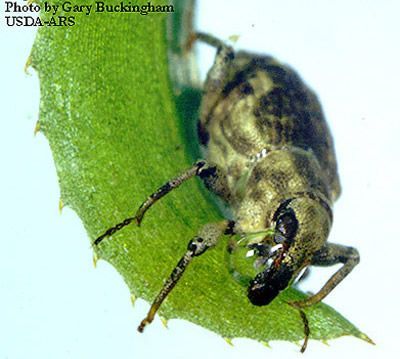
Credit: Gary Buckingham, USDA-ARS
Distribution
Bagous hydrillae is native to Australia and was originally collected from 21 sites throughout the Northern Territory and New South Wales. In Australia, higher numbers of weevils were collected from impounded water bodies, compared to rivers and creeks (Balciunas and Purcell 1991).
Description
Eggs
Eggs of Bagous species are usually white, and the outer membrane, or chorion, is transparent (Buckingham and Bennett 1994). Eggs of Bagous hydrillae are oval and 0.52 mm long by 0.27 mm wide (Figure 2); they are laid by the female inside the hydrilla stem. The female makes a hole in the stem with her mouthparts and then inserts the egg into the hole.
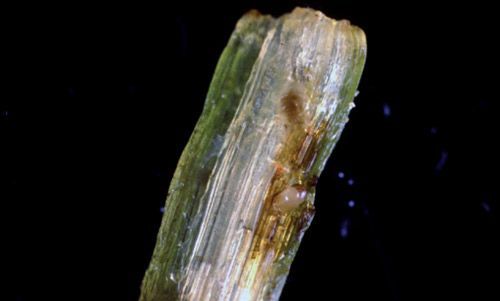
Credit: U.S. Army Engineer Research & Development Center
Larvae
Larvae of Bagous hydrillae are relatively non-descript and have not been described in detail in the literature. However, they have the general appearance of weevil larvae in that they are "comma-shaped" grubs with a soft body (Marvaldi 2003). The body appears to be translucent, and the gut is visible (Figure 3). There are three instars. The head capsules of Bagous species larvae are light brown, and ocelli are present (Gosik 2009, Buckingham and Bennett 1994). The antennae are one-segmented and conical (Gosik 2009). Like other weevil larvae, Bagous hydrillae larvae do not have legs. Larvae of the Curculionidae are usually found within dense materials, such as plant tissue (Marvaldi 2003). After hatching, Bagous hydrillae larvae bore into the surrounding tissue and are found within tunnels in hydrilla stems.
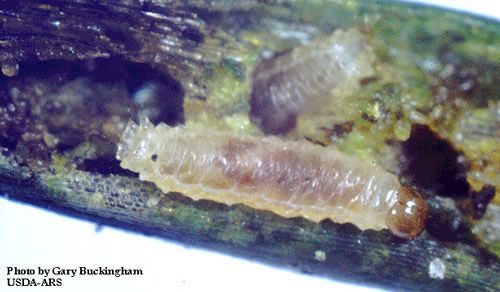
Credit: Gary Buckingham, USDA-ARS
Pupae
When third instars emerge from the stem to pupate, they are white in color but change to yellow. Pupae of Bagous hydrillae are referred to as naked as they do not form a protective covering, such as a cocoon (Figure 4). As the pupae approach the end of their developmental period, the eyes darken, and the body of the adult becomes apparent.
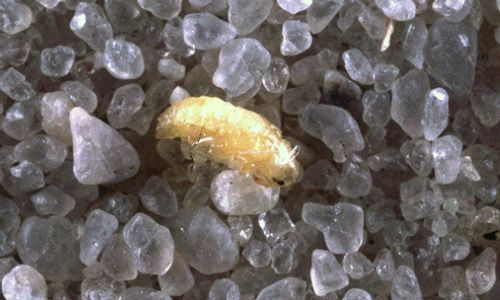
Credit: U.S. Army Engineer Research & Development Center
Adults
Adult hydrilla stem weevils are dark brown with lighter spots on the abdomen (Figure 5). Some individuals also have several larger light-colored areas on the elytra (wing covers) and thorax. Males can be distinguished from females by a broad shallow depression on the underside of the abdomen between the last pair of legs; this depression is absent in females (Balcunias and Purcell 1991).
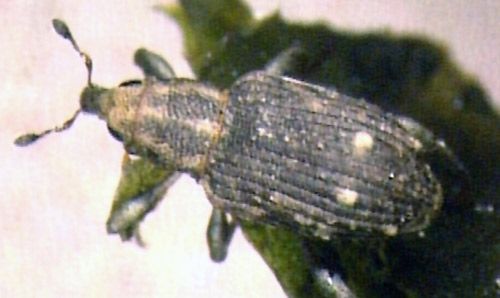
Credit: U.S. Army Engineer Research & Development Center
Life Cycle and Biology
Life stages include the egg, larva, pupa, and adult. The life cycle from egg to adult takes 12–14 days at 25°C (Balcunias and Purcell 1991). However, the larval development rate can be influenced by hydrilla quality, with decreased time to pupation when hydrilla nitrogen content is high and stems are soft (Wheeler and Center 1997). After a preoviposition period of 6.8 days, females start to lay eggs (Balcunias and Purcell 1991). The female makes a hole in the hydrilla stem with her mouthparts and lays individual eggs near leaf nodes (Balciunas and Purcell 1991). Females lay, on average, three eggs per day and around 100 eggs in a lifetime (Balciunas and Purcell 1991).
Larvae emerge within 54–66 hours (Balciunas and Purcell 1991). Larvae mine the stems of the hydrilla. Around 8 days after oviposition, the third instar emerges from the stem to pupate. Pupation occurs in terrestrial habitats, usually in stranded plant material or in the silt at the edge of the water body. The combined prepupal and pupal period is approximately 6 days (Balciunas and Purcell 1991). Adult weevils are active at night and live for approximately five weeks (Balciunas and Purcell 1991). They move underwater through plant material (Figure 6).
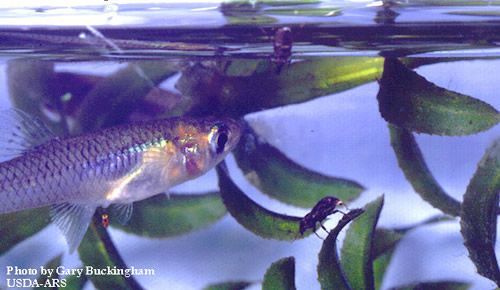
Credit: Gary Buckingham, USDA-ARS
The larvae of a closely related species, the hydrilla tuber weevil, Bagous affinis, feeds on hydrilla tubers. Although the female hydrilla stem weevil will lay eggs on tubers and the larvae will develop normally, the opposite is not true. The hydrilla tuber weevil larvae are not able to complete development on stem tissue and die before the prepupal stage (Wheeler and Center 2007a).
Hosts
In laboratory host-range tests, Bagous hydrillae appeared to be less host specific than is normally desirable in a biological control agent, feeding to some extent on 16 different plant species (Balciunas et al. 1996). Oviposition and larval survival were evaluated on these 16 plant species, and several other species of interest. Bagous hydrillae oviposited on 12/19 species (63%) including hydrilla (Balciunas et al. 1996). Larvae successfully developed to adults in all plant species that were attractive to ovipositing females (Balciunas et al. 1996). However, in the weevil's native range in Australia, hydrilla is the main host for this insect. In total, 1630 collections of 49 plant species including hydrilla were completed, and 90% of the Bagous hydrillae adults and 74% of the larvae collected as a result were found to be using hydrilla as a host (Balciunas and Purcell 1991).
In field surveys, weevils were collected from eight of 48 other plant species that were sampled, including an eelgrass species (Vallisneria gracilis F.M. Bailey), Brazilian waterweed (Egeria densa Planch), duck lettuce (Ottelia alismoides [L.] Pers.), coontail (Certophyllum demersum L.), a naiad species (Najas tenuifolia R. Brown), water snowflake (Nymphoides indica [L.] Kuntze), curly-leaf pondweed (Potamogeton crispus L.), and clasping-leaf pondweed (Potamogeton perfoliatus L.) (Balciunas and Purcell 1991). However, of the total collections, less than 10% of adults and 26% of larvae were on other plant species. The majority of the weevils not collected from hydrilla (80–85%) were collected from Vallisneria gracilis (Balciunas and Purcell 1991).
Whereas the laboratory studies indicated that Bagous hydrillae was a generalist, in the field it completes its life cycle on a narrow range of hosts. The difference in host specificity between feeding, oviposition and development host-range studies completed in the laboratory and the field host-range studies is believed to be caused by restrictions due to the terrestrial part of the life cycle. Most plants probably do not fragment in the same way that hydrilla does, so the larvae are not able to pupate in the soil and complete their life cycle.
Damage
The damage caused by the weevils is two-fold: larvae mining in the stems (Figure 7) and adults feeding around the leaf nodes (Figure 8). The adult feeding weakens the upper portions of the plant, and the stems will break causing fragmentation, whereby the mat of hydrilla breaks away from the roots and usually becomes stranded on the shoreline (Center et al. 2013). Additionally, adults feeding on the leaves create distinctive holes that have been described as "pepper shot" (Balciunas and Purcell 1991). Each larva tunnels through an average of 7.5 cm of stem before emerging from the stem to pupate (Balciunas and Purcell 1991). The galleries produced by the larvae turn black (O'Brien and Askevold 1992).
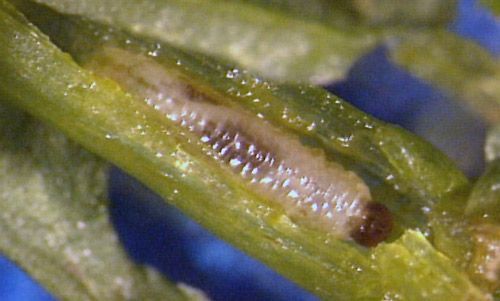
Credit: U.S. Army Engineer Research & Development Center
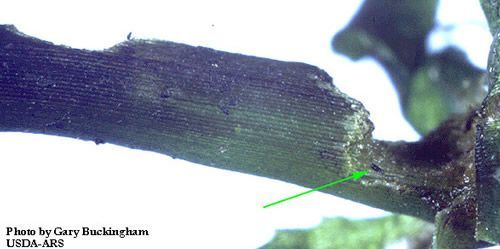
Credit: Gary Buckingham, USDA-ARS
Importance as a Biological Control Agent
The hydrilla stem weevil was selected as a potential biocontrol agent due to the insect's ability to damage hydrilla in its native range in Australia. Researchers in Australia reported that the damage caused by the larvae fragmenting the hydrilla created a mowed effect, removing the top 40 inches (100 cm) (Balciunas et al. 2002, Balciunas and Purcell 1991). Host specificity testing revealed that although the weevils are opportunistic and will feed, oviposit and successfully develop on many plant species in the laboratory, in the field their requirements for pupation make them more host specific.
A release permit was granted by the United States Department of Agriculture Animal and Plant Inspection Service, Plant Protection Quarantine Unit (USDA APHIS PPQ), and 320,000 adult Bagous hydrillae were released from 1991 to 1996. During this time, 100 releases were made at 19 sites in four states: Florida, Georgia, Alabama, and Texas (Center et al. 2013). Initially, it seemed like the weevils were established; at ten of the 19 sites, researchers were able to collect weevils up to a maximum duration of 4.5 years later. However, later collections were low in numbers, and continued efforts to find populations were unsuccessful (Center et al. 2013). As a result, the project was believed to have failed.
This belief was recently challenged when researchers found Bagous weevils in pitfall trap samples in Louisiana (Center et al. 2013). The samples were collected during a study to test a new trap design for sampling insects associated with aquatic plants (Parys and Johnson 2011). Although these captures were 580 km from the nearest release site, two weevils were confirmed to be the introduced Bagous hydrillae (Center et al. 2013). Interestingly, these weevils were collected from an area dominated by common salvinia, Salvinia minima Baker (Polypodiopsida: Salviniaceae), with no hydrilla presence recorded one year after the samples were collected (Center et al. 2013). Salvinia was not included in the host range tests completed prior to release of this insect in the United States (Buckingham and Bennett 1994).
The lack of establishment of the hydrilla stem weevil is most likely due to specific requirements of the life cycle. The larvae of Bagous hydrillae require relatively dry conditions to pupate. In its native range in Australia, the hydrilla fragments and the mat damaged by the adults will drift to the edge of the water body. Larvae leave the damp hydrilla and pupate in the relative dryness of previously stranded hydrilla or the soil. In Florida and most of the southeastern United States where this insect has been released, these conditions (i.e., stranded hydrilla around water bodies) are not common (Grodowitz et al. 1995). Therefore, the weevil is unable to successfully complete its life cycle.
Monitoring and Management
Several methods can be used to monitor weevil activity. Firstly, hydrilla can be collected and the leaves examined for the characteristic damage caused by the adult weevils. Stems may be dissected, and larval presence may be examined under a light microscope. However, Berlese funnels were found to be the most effective method of extracting adults and larvae from plant material (Balciunas and Purcell 1991). Monitoring for adult weevils can be done using ultraviolet (UV) black lights (Buckingham and Balciunas 1994). Although unintentional, Bagous hydrillae also were collected by using floating pitfall traps (Center et al. 2013, Parys and Johnson 2011).
Management is not necessary for the hydrilla stem weevil as this insect is not a pest in the United States.
Acknowledgment
The authors would like to acknowledge funding provided by the USDA NIFA RAMP Grant 2010-02825 that helped pay for the production of this article. The authors would like to acknowledge the reviewers that provided feedback on an early draft of the article, Dr. William Overholt and Dr. Verena Lietze.
Selected References
Balciunas JK, Purcell MF. 1991. Distribution and biology of a new Bagous weevil (Coleoptera: Curculionidae) which feeds on the aquatic weed Hydrilla verticillata. Journal of the Australian Entomological Society 30: 333–338.
Balciunas JK, Burrows DW, Purcell MF. 1996. Comparison of the physiological and realized host-ranges of a biological control agent from Australia for the control of the aquatic weed, Hydrilla verticillata. Biological Control 7: 148–158.
Balciunas JK, Grodowitz MJ, Cofrancesco, AF, Shearer JF. 2002. Pages 91-114. Hydrilla. In Van Driesche R et al. 2002 (eds.). Biological Control of Invasive Plants in the Eastern United States, USDA Forest Service Publication FHTET-2002-04, 413P. (21 April 2020).
Buckingham GR, Balciunas JK. 1994. Biological studies of Bagous hydrillae. Technical Report A-9496 U.S. Army Corps of Engineers, Waterways Experiment Station, Vicksburg, MS.
Buckingham GR, Bennett CA. 1994. Biological and host range studies with Bagous affinis, an Indian weevil that destroys hydrilla tubers. Technical Report A-948 U.S. Army Corps of Engineers, Waterways Experiment Station, Vicksburg, MS.
Center TD, Parys K, Grodowitz M, Wheeler GS, Dray FA, O'Brien CW, Johnson S, Cofrancesco A. 2013. Evidence of establishment of Bagous hydrillae (Coleoptera: Curculionidae), a biological control agent of Hydrilla verticillata (Hydrocharitales: Hydrocharitaceae) in North America? Florida Entomologist 96: 180–186.
Cuda JP, Frank JH. 2013. Florida's established arthropod weed biological control agents and their targets. University of Florida IFAS Electronic Data Information Source. (21 April 2020).
Gosik R. 2009. Description of the mature larva and pupa of Bagous lutulentus (Gyllenhal), with comments on its biology (Coleoptera: Curculionidae). Genus 20: 125–135.
Grodowitz J, Center T, Snoddy E. 1995. Current status of use of insect biocontrol agents for the management of hydrilla. Pages 134–141. In Proceedings of the 29th Annual Meeting of Aquatic Plant Control Research Program, 14-17 November 1994, Vicksburg, Mississippi, Miscellaneous paper A-93-2, U.S. Army Engineer Waterways Experiment Station, Vicksburg, MS.
Marvaldi AE. 2003. Key to the larvae of the South American subfamilies of weevils (Coleoptera, Curculionoidea). Revista Chilena de Historia Natural 76: 603–612.
O'Brien CW, Askevold IS. 1992. Systematics and evolution of weevils of the genus Bagous Germar (Coleoptera: Curculionidae), I. Species of Australia. Transactions of the American Entomological Society 118: 331–452.
Parys KA, Johnson SJ. 2011. Collecting insects associated with wetland vegetation: an improved design for a floating pitfall trap. The Coleopterists Bulletin 65: 341–344.
Wheeler GS, Center TD. 2007a. Hydrilla stems and tubers as hosts for three Bagous species: two introduced biological control agents (Bagous hydrillae and B. affinis) and one native species (B. restrictus). Environmental Entomology 36: 409–415.
Wheeler GS, Center TD. 2007b. Growth and development of the biological control agent Bagous hydrillae as influenced by hydrilla (Hydrilla verticillata) stem quality. Biological Control 8: 52–57.